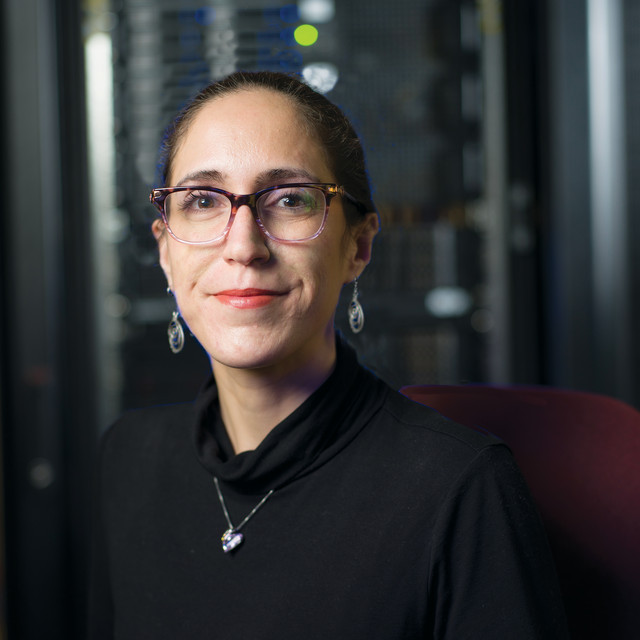Lynn Kamerlin, Ph.D
Computational Biophysics
Georgia Institute of Technology
Recruited: 2022
Lynn Kamerlin develops advanced computer models to simulate how certain biomolecules have evolved over time and how they interact with compounds and structures in their environment, from breaking down pesticides and plastics to regulating the growth of cancer cells.
A key area of her expertise is enzymes, the proteins that speed up and regulate chemical reactions in the body. In their simplest representation, enzymes can be thought of as a series of beads (amino acids) on a string. The type of beads and how they are ordered affect how they function, and the number and combination of amino acids on enzymes is an astounding figure, akin to the number of stars in the universe – squared.
Kamerlin uses supercomputers to uncover knowledge about enzymes and create models of their function and interaction. These models can reveal, for example, what would happen if a specific amino acid were swapped on an enzyme or put in a different position along the string. Her research has helped illuminate how the structure of an enzyme causes it to catalyze specific reactions – and how changing this structure could bring about all kinds of new benefits for humankind. For example, newly engineered enzymes could help break down organophosphates to make pesticides non-poisonous or be used as biotherapeutics to treat human diseases.
Connecting enzymes from the past to those of today – and ultimately, those in the future – is central to Kamerlin’s work. One way to achieve this is through an approach called ancestral sequence reconstruction. After combining the sequences of several modern enzymes, Kamerlin uses probability models to mathematically predict what kind of sequences could have given rise to the ones we have today.
This approach allows her and other researchers to try to “resurrect” ancient enzymes that may have relevance to answering today’s needs. By reconstructing and characterizing these enzymes in the laboratory, it’s possible to get insight into how enzymes could have emerged and evolved over vast spans of evolutionary times. As enzymes regulate the chemical reactions that make life possible, understanding how they evolve gives us an intimate window into who we are and where we came from.
From an engineering perspective, older enzymes had broad application and often could withstand extreme temperatures. This makes them ideal candidates to tweak for new purposes, such a breaking down PET plastic – one work in progress for Kamerlin and her collaborators. By contrast, modern enzymes have evolved in such a way that they are highly specialized, so it’s not as easy to repurpose them for new functions.
A powerful potential application of Kamerlin’s research involves reducing the toxicity to humans of some chemicals. Organophosphates, present in pesticides and nerve gases, are relatively new chemicals. Some enzymes in nature that have evolved since the advent of organophosphates can break them down, but the degradation process is extraordinarily slow. Kamerlin believes that accelerating the evolution of these effective enzymes – using her tools of supercomputing and modeling – could bring a cure for poisoning by organophosphates.
Enzymes play key roles inside the body – and inside every cell. They help with everyday processes such as digesting food, for example, but how they function – or malfunction – can also have consequences for disease. Kamerlin’s models have helped understand the role certain enzymes play in the development of tumors. Modelling how sections of different enzymes interact with other cells can help identify what causes cells to become cancer cells – the first step in developing possible treatments.
Kamerlin’s publications have largely centered on computational biophysics, and she has published over 140 papers and contributed over 65 crystal structures as part of her work. Crystal structures form the starting points for Kamerlin’s simulations. They help reveal properties of enzymes – e.g., how they move – before simulating enzyme structures over time to understand how evolution would have impacted them. She has also used her skills as a scientist to explore and advocate for diversity, inclusion and equity in academia, a topical area included in her long line of published articles.
Research
- Mapping the evolution of life by understanding the steps in enzyme evolution
- Modeling human disease at a molecular level
- Understanding communication both within and between biological systems
- Designing new enzymes for therapeutics and sustainable chemistry applications
Choosing Georgia
“The department at Georgia Tech is a really strong department, and there are a lot of people who are doing things that are very relevant to my work. And the proximity to Emory is also great. The GRA and its investment in science and research and in tomorrow is a big draw. And it is great to be a beneficiary together with all these incredible group of people who are GRA Eminent Scholars.”

